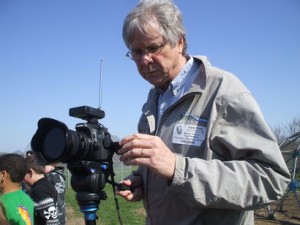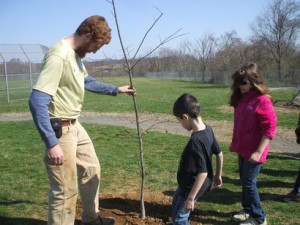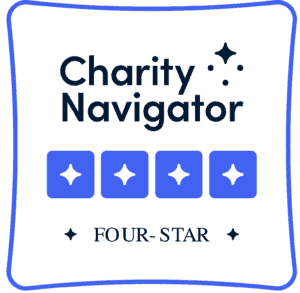In two articles last week, Martinsburg’s Journal newspaper in Berkeley County, WV covered the tree planting at T.A. Lowery Elementary School led by the Cacapon Institute’s Tanner Haid, with help from the Elks Run Watershed Group and the Jefferson County Izaak Walton League. In the first article, staff writer Jenni Vincent talks with Downstream Executive Director Bill Howard about helping local conservation groups get the word out through omnimedia communications. In the second, she talks about the Cacapon Institute’s Project CommuniTree tree planting project with T.A. Lowery teacher Marsha Young.
Thanks to the Journal for allowing us to reprint both articles here. Enjoy.
Getting the environmental message out
April 23, 2014
By Jenni Vincent – Journal Staff Writer (jvincent@journal-news.net) , Journal News
SHENANDOAH JUNCTION – Bill Howard couldn’t help but smile as T.A. Lowery Elementary students eagerly took turns adding dirt to a hole that had been dug for planting a white oak tree behind their school.
But it won’t be just a personal memory for Howard, who serves as executive director of the Berryville, Va.-based group Downstream Project.

Part of the nonprofit organization’s mission is to help other groups get their message out to the public, he said, pausing for a moment before beginning to videotape another group of students working near the playground.
Downstream Project executive director Bill Howard videotaped T.A. Lowery students as they were planting trees on their school campus and will share this with other environmental activists who are also working to make a difference locally.
“Our mission is to support our partners through communications and we do it through what we call omnimedia, which includes video, web design, social media and graphics. We help with identity development, sometimes known as branding, so people will remember these organizations and the efforts they represent,” Howard said.
Keeping information flowing helps keep the public interested in important environmental issues, he said, adding that this kind of outreach also helps keep an organization’s constituents engaged.
The good news is that there’s plenty of environmental activism taking place locally, and that’s good for the area’s natural environment.
In addition to the students’ tree planting, the Jefferson County Parks and Recreation Commission recently helped his organization – along with the Cacapon Institute and West Virginia Conservation Agency – coordinate the planting of 24 trees in a riparian area along Elks Run that borders the Briarwood subdivision.
“We had a great turnout, and there was also a cleanup of the dog park. There was also a Boy Scout troop who helped by picking up bags and bags of trash,” he said, adding that all of these activities will have a positive impact on the impaired Elks Run because of what won’t be washing into it.
Ranson officials recently organized a large tree planting along the W.Va. 9 bike path, which included 100 from the Cacapon Institute’s Project CommuniTree and another 200 trees donated by a local nursery.
“When you look at the big picture, how many people and groups are working together to make an environmental difference, it really is impressive,” Howard said.
Better communication continues to be vital, he said.
“One of the things we’ve been learning by working with a lot of small watershed groups like Sleepy Creek in Morgan County, Elks Run here and the Blue Ridge Water Coalition up on the mountain is the important work they are doing – but also a need to improve communication among the groups so they can share more readily,” Howard said.
As a result, the Downstream Network is being developed -an aggregate website where news and information from a collection of watershed groups can all appear, with links back to the individual group’s websites, he said.
Every day is Earth Day at T.A. Lowery
April 23, 2014
By Jenni Vincent – Journal Staff Writer (jvincent@journal-news.net) , Journal News
SHENANDOAH JUNCTION – Dozens of T.A. Lowery Elementary School students got a jump on Earth Day recently when they worked with area conservationists to plant trees on their campus.
That’s when representatives from the Cacapon Institute, Jefferson County Izaak Walton League of America and Downstream Project joined forces with teacher Marsha Young, who successfully applied for a Project CommuniTree grant after finding out how much her students would learn about the environment while planting trees.

“For example, we do need trees on the playground to give them shade. They are also learning about science and the environment because trees are important to animals as well as help provide habitat,” she said, smiling as youngsters eagerly began to arrive to do their part behind the school.
Every day is Earth Day at T.A. Lowery Elementary School, where Cacapon Institute urban forestry coordinator Tanner Haid recently assisted students as they planted 16 new trees on their campus. The school’s students are no strangers to conservation projects because they have an ongoing tree-planting project — including a walking path featuring trees that are native to West Virginia.
“We also want them to know how important trees are when it comes to healthy air and clean water,” Young said.
Sixteen trees, each measuring 6- to 10-feet tall, were planted April 10, including several native species such as white oak and some flowering trees such as dogwood, redbud and serviceberry that will help add color in the spring, she said.
“On the walking trail we decided to plant sugar maples because they are the state tree of West Virginia and they will be especially pretty in the fall,” Young said.
Urban forestry coordinator Tanner Haid said the Cacapon Institute’s Project CommuniTree has become popular since its 2008 inception in Moorefield.
“In 2011, we received significant funding to increase this work throughout the eight counties of the Eastern Planning – the Potomac River headwaters that drain into the Chesapeake Bay. We’ve already done 47 projects at community sites – schools, parks, road right-of-ways. Any of these kinds of places can apply for a CommuniTree kit, which includes trees, mulch and just about everything they need. The kits are free, the groups just have to organize the planting,” Haid said, adding that an additional 19 projects are scheduled for this year.
“This year we will be planting a little over 500 trees, and the program as a whole is probably responsible for about 1,500, so we’ll be getting close to the 2,000 mark soon. They picked a good mix of shade and flowering trees to plant here, so that should work out well,” he said.
In addition to helping children in six classes plant trees, Haid also explained how their efforts would benefit the watershed – a term that some students hadn’t heard before, but quickly wanted to know more.
“Always remember that whatever any of us does has an impact on someone else,” he said, as several students nodded in agreement.
Darrell Propst, conservation committee chairman for the local Izaak Walton group, said this is the kind of activity in which he and other members are happy to help.
“We could plant trees anywhere. But what we like to encourage is that cooperation among others, especially our young people, because this kind of hands-on activity teaches them to appreciate nature and their environment,” Propst said.
“It’s been clear that a lot of the kids were really excited this morning, girls as well as boys. And this is definitely better than kids wanting to just sit on a couch playing video games. After we get going, they are usually all pretty excited about getting dirty,” he said with a chuckle.
– Staff writer Jenni Vincent can be reached at 304-263-8931, ext. 131.
© Copyright 2014 Journal News. All rights reserved. This material may not be published, broadcast, rewritten or redistributed.


Wonderful coverage! And great blogging. Keep up the good work!